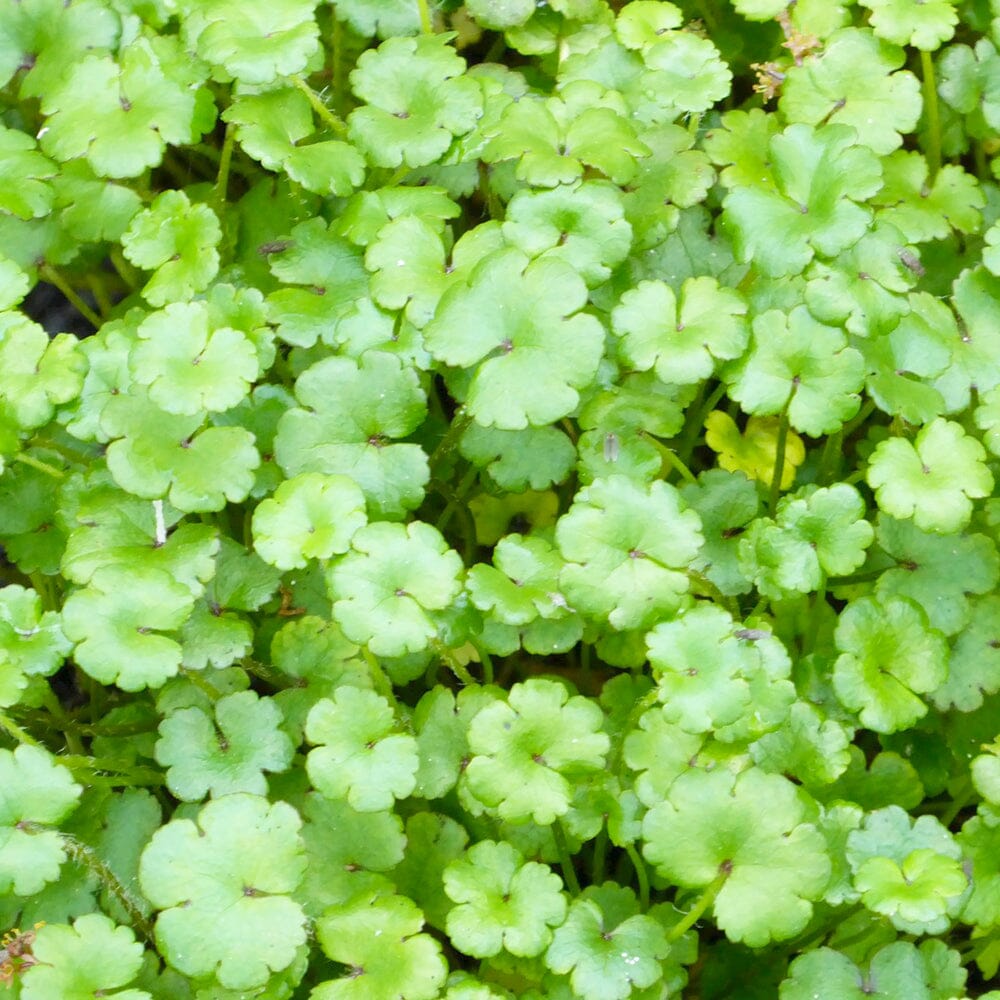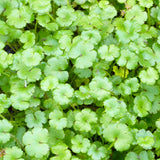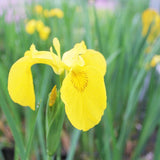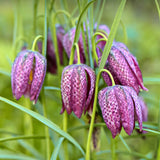Hydrocotyle Nova Zealand Aquatic Pond Plant Asian Pennywort
Hydrocotyle sibthorpioides, commonly known as Asian pennywort or marsh pennywort, is a small, creeping perennial plant native to Asia. It is often grown as an aquatic or semi-aquatic plant and is popular for its attractive foliage and ground-covering habit. Here is a detailed description and care guide for Hydrocotyle sibthorpioides:
Description:
Foliage: The leaves of Hydrocotyle sibthorpioides are small, round, and bright green in color. They are deeply lobed and have scalloped edges, resembling miniature umbrellas. The leaves are arranged in a dense, low-growing rosette pattern.
Growth habit: This plant forms dense mats or carpets of foliage, spreading through stolons that root at the nodes and rapidly fill in the surrounding area.
Flowers: Hydrocotyle sibthorpioides produces small, inconspicuous white or pale pink flowers that are held above the foliage on thin stalks. The flowers may appear in clusters during the summer months.
Care Guide:
Light: Hydrocotyle sibthorpioides thrives in partial shade to full sun. In indoor aquariums, it can tolerate moderate lighting conditions.
Water: This plant requires consistently moist to wet conditions, making it ideal for growing in ponds, water gardens, or containers with water features. It can also be grown as a bog plant in consistently moist soil.
Temperature: Hydrocotyle sibthorpioides is adaptable to a wide range of temperatures. It can tolerate both cool and warm conditions but prefers temperatures between 68°F (20°C) and 86°F (30°C).
Soil: It prefers rich, loamy soil with good moisture retention. In aquatic settings, it can be planted directly in the substrate or placed in containers with aquatic soil.
Fertilizer: Fertilization is not typically necessary for Hydrocotyle sibthorpioides, as it can obtain nutrients from the water or soil. However, if grown in a container or poor soil, a balanced liquid fertilizer can be applied sparingly during the growing season.
Maintenance: Regular trimming is required to control the growth and maintain the desired appearance. Prune any excess growth to prevent it from spreading excessively. It is a good idea to remove any dead or decaying leaves to maintain the plant's health.
Propagation: This plant can be propagated by division, where the rooted stolons can be separated from the parent plant and replanted in new locations.
Overall, Hydrocotyle sibthorpioides is a versatile and low-maintenance plant that adds a lush and vibrant touch to aquatic environments. Whether grown in ponds, water gardens, or indoor aquariums, it provides an attractive ground cover and helps create a natural and serene atmosphere.
Selection of Plants:
Choose appropriate oxygenating plants that are suitable for the size and depth of your pond. Common oxygenating plants include Hornwort (Ceratophyllum), Anacharis (Elodea canadensis), Waterweed (Elodea densa), and Watermilfoil (Myriophyllum species).
Placement:
Place oxygenating plants in the water at a depth where their foliage is fully submerged. Distribute the plants evenly throughout the pond, ensuring they receive adequate sunlight for photosynthesis.
Water Quality:
Oxygenating plants play a crucial role in maintaining good water quality by absorbing excess nutrients, competing with algae for resources, and releasing oxygen through photosynthesis. Regularly monitor water quality parameters such as pH, ammonia, nitrite, and nitrate levels to ensure they are within suitable ranges for the plants.
Nutrient Levels:
Oxygenating plants benefit from moderate nutrient levels in the water, but excessive nutrients can lead to rapid algae growth. Avoid over-fertilization or excessive organic matter accumulation in the pond, as it can negatively impact oxygenating plants.
Pruning and Maintenance:
Regularly thin out and prune oxygenating plants to prevent overcrowding and ensure healthy growth. Remove any dead or decaying plant material promptly to maintain water quality and prevent the release of excess nutrients.
Winter Care:
Some oxygenating plants may need special attention during winter, especially in colder climates. If your pond experiences freezing temperatures, consider moving potted plants indoors or provide insulation to protect them. In milder climates, oxygenating plants may continue to grow during winter, providing oxygen and supporting the pond ecosystem.
Propagation:
Some oxygenating plants can be propagated by dividing or taking cuttings. Follow specific instructions for each plant species to propagate them successfully and maintain a healthy population in your pond.
Monitoring and Control:
Regularly observe the growth and condition of oxygenating plants to identify any signs of disease, pests, or nutrient deficiencies. If needed, control excessive growth by removing excess plant material, but be careful not to remove too much at once, as it can disturb the pond's ecological balance.
Introduction of New Plants:
Before introducing new oxygenating plants into your pond, ensure they are free from pests, diseases, or invasive species. Avoid introducing non-native species that may become invasive and harm the local ecosystem. By following these general tips and care guidelines, you can maintain healthy oxygenating plants in your pond. They will contribute to the overall oxygenation of the water, provide habitat for beneficial organisms, and promote a thriving pond ecosystem.
































